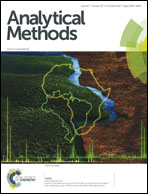Sensitive and simple detection of trace hydrogen peroxide based on a resonance light scattering assay
Abstract
Under weak acidic conditions, with haemoglobin (Hb) as a mimetic peroxidase, the oxidation reaction between H2O2 and KI was catalysed by haemoglobin to form I2, which combined with excessive I− to form I3−. I3− then reacted with gold nanoparticles (AuNPs) to produce AuI2−, which decreased the resonance light scattering intensity of the gold nanoparticles at 575 nm. The resonance light scattering (RLS) intensity linearly decreased as the hydrogen peroxide concentration increased. On this basis, a new method for the resonance light scattering determination of hydrogen peroxide has been developed, and the optimum reaction conditions, influential factors and applications were investigated. Under the optimal reaction conditions, hydrogen peroxide concentrations of 3.25 × 10−7–2.60 × 10−5 mol L−1 were linearly correlated with the reduction in the resonance light scattering intensity (ΔI) with a correlation coefficient of 0.9992 and a detection limit of 2.48 × 10−7 mol L−1. The new method has been applied to the analysis of hydrogen peroxide in milk samples with satisfactory results.


 Please wait while we load your content...
Please wait while we load your content...